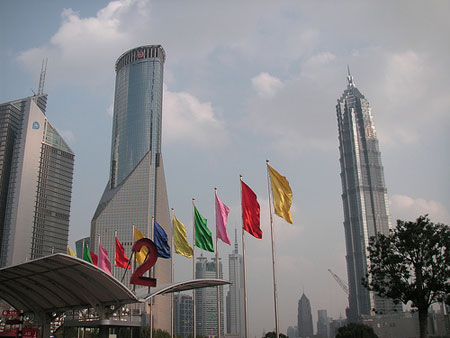Source: The New Internationalist
|
Gene Zhang under a CC Licence |
On 1 January 2010, the China-ASEAN (Association of Southeast Asian Nations) Free Trade Area went into effect. Touted as the world’s biggest Free Trade Area, CAFTA is billed as having 1.7 billion consumers, with a combined gross domestic product of $5.93 trillion and total trade of $1.3 trillion.
Under the agreement, trade between China and six ASEAN countries (Brunei, Indonesia, Malaysia, the Philippines, Singapore and Thailand) has become duty-free for more than 7,000 products. By 2015, the newer ASEAN countries (Vietnam, Laos, Cambodia and Burma) will join the zero-tariff arrangement.
The propaganda mills, especially in Beijing, have been trumpeting this new free trade deal as ‘bringing mutual benefits’ to China and ASEAN. A positive spin on CAFTA has also come from President of Philippines, Gloria Arroyo, who hailed the emergence of a ‘formidable regional grouping’ that would rival the US and the European Union.
The reality, however, is that most of the advantages will probably flow to China. At first glance, it seems like the bilateral relationship has been positive. After all, demand from a Chinese economy growing at a breakneck pace was a key factor in Southeast Asian growth beginning around 2003, after a period of low growth following the 1997/1998 Asian financial crisis.
Counting on China
During the current international recession, ASEAN governments are counting on China, whose GDP in the fourth quarter of 2009 rose 10.7 per cent, to pull them out of the doldrums.
Yet the picture is more complex than that of a Chinese locomotive pulling the rest of East Asia along with it on a fast track to economic nirvana.
Low wages, many in Southeast Asia fear, have encouraged local and foreign manufacturers to phase out their operations in relatively high-wage Southeast Asia and move them to China. There appears to be some support for this. China’s devaluation of the yuan in 1994 had the effect of diverting some foreign direct investment (FDI) away from Southeast Asia.
The trend of ASEAN losing ground to China accelerated after the 1997 crisis. In 2000, FDI in ASEAN shrank to 10 per cent of all investment in developing Asia, down from 30 per cent in the mid-1990s. The decline continued in the rest of the decade, with the UN World Investment Report attributing the trend partly to ‘increased competition from China’.
Trade has been another, perhaps greater, area of concern. Massive smuggling of goods from China has disrupted practically all ASEAN economies. For instance, with some 70-80 per cent of shops selling smuggled Chinese shoes, the Vietnamese shoe industry has suffered badly.
Now there are fears that CAFTA will simply legalize smuggling and worsen the already negative effects of Chinese imports on ASEAN industry and agriculture.
For Chinese officials, the benefits to China of free trade with ASEAN are clear. The aim of the strategy, according to Chinese economist Angang Hu, is to more fully integrate China into the global economy as the ‘center of the world’s manufacturing industry’.
 |
|
Luijaizeri Financial and Trade Zone in Shanghai, China. Hank LeClair under a CC Licence |
A central part of the plan was to open up ASEAN markets to Chinese manufactured products. In light of growing popularity of protectionist sentiments in the US and European Union, Southeast Asia, which absorbs only around 8 per cent of China’s exports, is seen as having tremendous potential to absorb more Chinese goods. China’s trade strategy is described by Hu as a ‘half-open model’ that is ‘open or free trade on the export side and protectionism on the import side’.
Worrying trends
Despite brave words from Arroyo and other ASEAN leaders, it is much less clear how their countries will benefit from the ASEAN-China relationship.
Certainly, the benefits will not come in labour-intensive manufacturing, where China enjoys an unbeatable edge by the constant downward pressure on wages exerted by migrants from a seemingly inexhaustible rural work force that makes an average of $285 a year. Certainly not in high tech, since even the US and Japan are scared of China’s remarkable ability to move very quickly into high-tech industries even as it consolidates its edge in labour-intensive production. Will agriculture in ASEAN be a net beneficiary? China is clearly super-competitive in a vast array of agricultural products, from temperate crops to semi-tropical produce and in agricultural processing.
Despite brave words from Arroyo and other ASEAN leaders, it is much less clear how their countries will benefit from the ASEAN-China relationship
Moreover, even if under CAFTA, ASEAN were to gain or retain competitiveness in some areas of manufacturing, agriculture and services, it is highly doubtful that China will depart from what Hu calls its ‘half-open’ model of international trade.
What about raw materials? Yes, of course, Indonesia and Malaysia have oil that is in scarce supply in China; Malaysia does have rubber and tin and the Philippines has palm oil and metals.
But a second look makes one wonder if the relationship with China is not reproducing the old colonial division of labour, whereby low-value-added natural resources and agricultural products were shipped to the centre while the Southeast Asian economies absorbed high-value added manufactures from Europe and the US.
These trends are likely to accelerate under CAFTA, but with a difference: China will beat out the country’s ASEAN neighbours in achieving control of the domestic market.
To sum up, the trade agreement is likely to disadvantage ASEAN. Even with the temporary exemptions of certain areas from full trade liberalization, ASEAN would be locked into a process where the only direction that barriers to super-competitive Chinese industrial and agricultural goods will go is downwards.
Copyright IPS 2010
